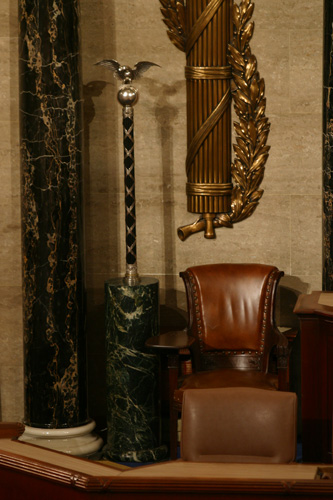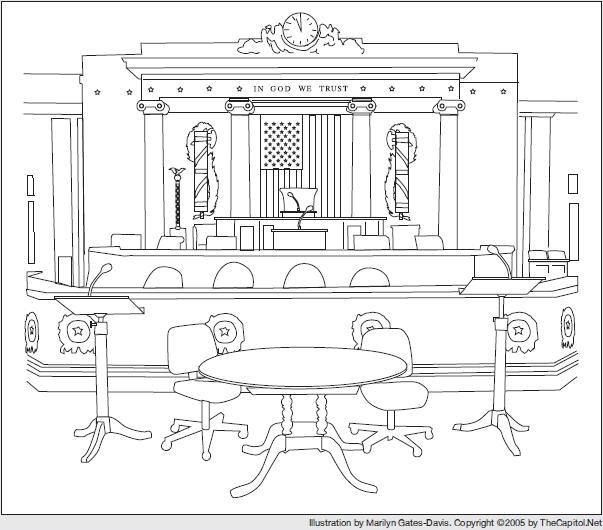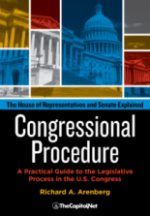From the Congressional Glossary – Including Legislative and Budget Terms
Mace
Symbolism in the House Chamber
The mace is the symbol of authority of the House of Representatives. The mace is 46 inches high and consists of 13 thin ebony rods representing the original 13 states of the union. The rods are bound together by four crossing ribbons of silver, pinned together and held at the bottom and at the top by silver bands. The bands are decorated with floral borders and a repoussé design. The name “Wm. Adams/Manufacturer/New York/1841.” is engraved in the cartouche, located in the front center of the bottom band. This shaft is topped by a silver globe 4-1/2 inches in diameter and engraved with the seven continents, the names of the oceans, lines of longitude, and the major lines of latitude. The Western Hemisphere faces the front. The globe is encircled with a silver rim marked with the degrees of latitude, on which is perched an engraved solid silver eagle with a wingspan of 15 inches. The total weight of the mace is 10 pounds.

The mace, the symbol of the authority of the House and of the office of the sergeant at arms, is in the custody of the sergeant at arms. At the opening of a session of the House, a staffer in white gloves places the mace on a pedestal to the Speaker’s right. The mace is removed from its pedestal when the Committee of the Whole is meeting and moved to a lower, less visible position near the Speaker’s dais. After consideration of amendments in the Committee of the Whole, the committee rises and reports the measure back to the House. The mace is replaced on its pedestal, and the Speaker or Speaker pro tempore assumes the chair.

The Speaker or Speaker pro tempore sits on the uppermost level of the dais, and the mace is on the pedestal to the Speaker’s right if the House is meeting as the House. If the House is meeting as the Committee of the Whole House on the State of the Union, the chairman of the Committee of the Whole occupies this level, and the mace is placed on a lower pedestal. If Congress is conducting a joint session or meeting, the vice president is seated on this level with the Speaker, a second chair having been added. (See § 6.110, Committee of the Whole: Debate; and § 6.111, The Mace.)
One might also see one of the parliamentarians to the Speaker’s or chairman’s right, advising on parliamentary statements or rulings. A time clerk stands on the presiding officer’s left. The reading clerk as well as several other clerks occupy the middle level. The reading clerk is regularly directed by the Speaker or the chairman of the Committee of the Whole to read measures or amendments or provide other information to the membership, which he does from the lectern on this level. Members may speak from the well of the House, using the Democratic lectern on the Speaker’s right or the Republican lectern on the Speaker’s left. The official reporters of debate use the table and chairs.
§ 11.12 View of the Speaker’s Dais and Well of the House, in Congressional Deskbook
Also see
- Congress Seating Charts
- Chamber (CongressionalGlossary.com)
- Sergeant at Arms (CongressionalGlossary.com)
- Committee of the Whole (CongressionalGlossary.com)
- Speaker (CongressionalGlossary.com)
- Well (CongressionalGlossary.com)
- § 6.111 The Mace, § 11.12 View of the Speaker’s Dais and Well of the House, in Congressional Deskbook
More
- “Guide to Individuals Seated on the House Dais,” CRS Report 98-396 (7-page PDF
 )
) - “House Sergeant at Arms: Fact Sheet on Legislative and Administrative Duties,” CRS Report 98-835 (11-page PDF
 )
) - “Sessions, Adjournments, and Recesses of Congress,” CRS Report R42977 (31-page PDF
 )
) - “Support Offices in the House of Representatives: Roles and Authorities,” CRS Report RL33220 (24-page PDF
 )
) - “House Sergeant at Arms: A Primer,” CRS In Focus IF11727 (5-page PDF
 )
) - “Senate Sergeant at Arms and Doorkeeper: A Primer,” CRS Infocus IF11728 (5-page PDF
 )
)
Courses
- Congressional Operations Briefing – Capitol Hill Workshop
- Drafting Federal Legislation and Amendments
- Writing for Government and Business: Critical Thinking and Writing
- Custom Training
- Drafting Effective Federal Legislation and Amendments in a Nutshell, Audio Course on CD
- Congress, the Legislative Process, and the Fundamentals of Lawmaking Series, a Nine-Course series on CD
Publications
CongressionalGlossary.com, from TheCapitol.Net
For more than 40 years, TheCapitol.Net and its predecessor, Congressional Quarterly Executive Conferences, have been teaching professionals from government, military, business, and NGOs about the dynamics and operations of the legislative and executive branches and how to work with them.
Our custom on-site and online training, publications, and audio courses include congressional operations, legislative and budget process, communication and advocacy, media and public relations, testifying before Congress, research skills, legislative drafting, critical thinking and writing, and more.
TheCapitol.Net is on the GSA Schedule, MAS, for custom on-site and online training. GSA Contract GS02F0192X
TheCapitol.Net is now owned by the Sunwater Institute.
Teaching how Washington and Congress work ™





